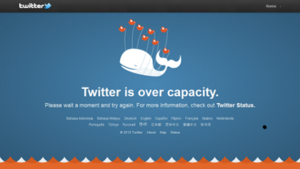
Recently, my Twitter followers were annoyed to see my feed taken over by an electronic device, which was robotically announcing my travel destinations, and occasionally (when I let it) that I’d arrived at those destinations. The device in question was a new sat-nav from TomTom called the GO 1005 World, which I was testing for a website. It has built-in Twitter connectivity, so it can send journey-related messages. This concept clearly has its faults. The generally negative reaction to these updates highlighted a mismatch between the kind of automated postings the device produces and the nature of the Twitter service it uses to do so.
But although at least one journalist friend saw this as TomTom trying to cash in on a social networking trend, the sat-nav’s Twitter ability does potentially have its uses, at least in theory. There are circumstances where you might want to let people know when to expect you, without having to take the time to find their contact information and construct a custom message for each one. We’re all short of time, and this makes your estimated arrival time easily accessible to anyone who might need to know (including your employer…)

You might argue that you really should be taking the time to construct personal messages directed at the specific people concerned with your current journey, and that view definitely has some weight. However, this is not just a problem with what TomTom has implemented in its device, but the whole ethos of social media in general, best summed up by Sherry Turkle‘s excellent analsysis in her recent book Alone Together. Social networks in general, and Twitter in particular, can easily lead you to talking at people rather than to them, treating your friends like a uniform audience rather than individuals with whom you have a direct relationship.
There’s an even scarier prospect in store with all this, though. Right now, despite the undoubted power of search engines, they still provide a very unstructured view of all the mind-bending quantity of disconnected information stored on the plethora of digital networks out there. But there are plans afoot to categorise information in a more consistent fashion. They may not have gotten very far just yet, but possibly by the end of this decade, all the things you say about yourself online, including your whereabouts as documented through sat-navs that Tweet, or checking in with Foursquare and Facebook, will be clearly connected to your unified digital identity.
In the near future, it may not be very hard at all to piece together a complete picture of your habits not just online, but in the real world too. Tie that in with freely accessible feeds from security cameras, probably also more meaningfully categorised than is currently the case, and some pretty scary prospects become possible – like anonymous individuals discovering where you are going, then watching the surveillance feed of what you are doing there. More and more aspects of our lives are becoming radically transparent to anyone who wishes to look. We really need to start thinking about how we feel about that.
Related Posts









I am always slightly bemused by the reaction to automated tweets. Often, people seem disproportionately upset by such a thing. Tweets about someone having garlic bread with a mean are fine, but an automated tweet to say you have arrived at a destination? Beyond. The. Pale.
I find ‘The Rules of Twitter’ or any other social network it seems to me are more ‘Things I Don’t Like and that some of my friends or followers agree with’ Because more than one person may have the same opinion there’s a feeling of ‘rightness’ applied to the aggrieved.
Whenever I see someone tweeting about ‘The rules’ or what someone doesn’t like I can’t help screaming at the screen “UNFOLLOW THEM THEN YOU PLANK*” *Plank may not be the actual term used.
Anyway, your automated tweets didn’t affect me in any way other than me thinking “he’s going to get a lot of shit for these tweets”
I didn’t get as much flack as you might expect, and I don’t think I lost followers in any significant numbers. As I said in my post, I can still see the potential value in the concept, but the implementation needs some work. TomTom obviously still thinks it’s a good idea, as the feature has just been added to the iPhone / iPad version of the software. And, in fact, ALK’s CoPilot Live has had a similar feature for over a year. It’s just that TomTom decided to make a big song and dance about it.
More and more of our lives ARE becoming radically transparent to anyone who wishes to look not IS.
I’ve added the word “aspects” to make this sentence clearer, as “more” can be singular or plural depending on the noun it modifies, which in this case was implicit rather than explicit. Thanks, though, for seeing the bigger picture of the argument and not focusing on the details. ;^>